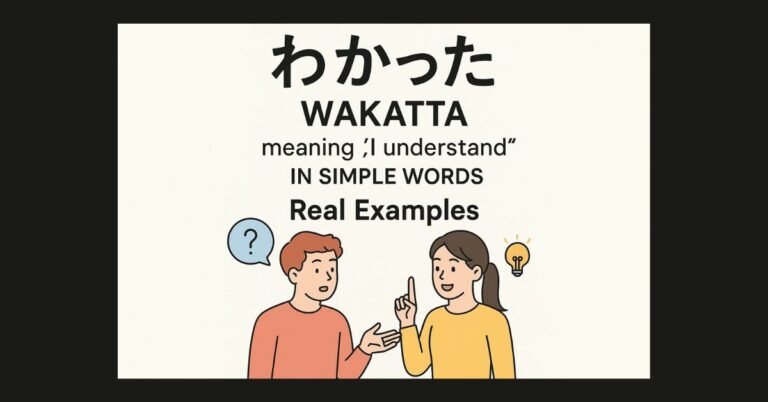If you’ve watched anime or talked to Japanese friends, you’ve probably heard the word wakatta (分かった). It’s one of the most common phrases you’ll hear in everyday Japanese. At its core, it means “I understood” or “Got it.” But this small word carries a lot of cultural meaning and grammar behind it.
In this guide, we’ll explain the real meaning of wakatta, how it’s used, and even clear up the common mix-up with “wakata.” You’ll also see real examples so you can use it naturally in your own conversations. Let’s jump in and make it easy to understand.
What Does “Wakatta” Mean in Japanese?
The word wakatta (分かった) is the past tense of the verb wakaru, which means “to understand.” You use it when you’ve just grasped something someone explained. It’s short, easy, and perfect for casual chats.
Some learners confuse it with wakata, but that’s just a misheard version of wakatta. Native speakers don’t use “wakata” in proper Japanese. You’ll often hear wakatta in anime, dramas, and daily conversations to show agreement or sudden realization.
Knowing when to use wakatta and when to use its polite form wakarimashita makes a big difference in how natural your Japanese sounds.
The Grammar Behind “Wakatta”
Here’s how it works:
- Wakaru (分かる) → Dictionary form = “to understand”
- Wakatta (分かった) → Informal past tense = “I understood” / “Got it”
In Japanese, the past tense here shows that understanding has already happened—like saying, “It clicked!” That’s why wakatta often pops up in everyday conversations.
And remember—wakata isn’t correct Japanese, it’s just something beginners mishear.
When to Use “Wakatta” vs. Other Forms of “Wakaru”
Japanese changes depending on how polite you want to be. Here’s a quick comparison:
| Polite Form | Casual Form | Meaning | Usage |
|---|---|---|---|
| Wakarimasu | Wakaru | I understand | Present/future (formal & casual) |
| Wakarimashita | Wakatta | I understood | Past (formal & casual) |
| Wakarimasen | Wakaranai | I don’t understand | Present/future negative |
| Wakarimasen deshita | Wakaranakatta | I didn’t understand | Past negative |
Quick tip:
- Use wakarimashita for formal situations (teachers, elders, work).
- Use wakatta with friends, family, or in relaxed settings.
Real-Life Examples of “Wakatta”
Example 1 – Basic acknowledgment
Japanese: 明日の会議は9時からです。分かった?
Romaji: Ashita no kaigi wa 9-ji kara desu. Wakatta?
English: Tomorrow’s meeting is at 9 o’clock. Got it?
Response: はい、分かった。 (Hai, wakatta) – Yes, I understand.
Example 2 – After instructions
Japanese: この書類に記入して、終わったら私に渡してください。
Romaji: Kono shorui ni kinyū shite, owattara watashi ni watashite kudasai.
English: Fill out this form and give it to me when done.
Response: 分かった、やっておくよ。 (Wakatta, yatte oku yo) – Got it, I’ll handle it.
Example 3 – Sudden realization
Japanese: あっ、分かった!答えは42だ!
Romaji: A, wakatta! Kotae wa 42 da!
English: Ah, I got it! The answer is 42!
How to Practice “Wakatta” Naturally
The best way to get comfortable with wakatta is to hear it in action—anime, dramas, and conversations are perfect for this. Listen to how people say it, notice the tone, and copy it.
You might hear wakata, but remember—it’s just a mistake people make when they mishear the word.
Cultural Meaning of “Wakatta”
In Japanese culture, wakatta isn’t just “I understand.” It can also mean you agree, respect the other person’s words, or are ready to follow instructions.
It’s softer than just saying “okay” and feels more thoughtful. Saying wakata instead might make you sound unnatural to native speakers.
Common Phrases Related to “Wakatta”
- Wakarimasuka? – Do you understand? (formal)
- Wakaru? – You get it? (casual)
- Yoku wakaranai – I don’t really understand
- Wakatte iru – I already understand / I know
- Wakatte kudasai – Please understand
These help you respond in different situations and make your Japanese sound natural.
Tips for Sounding Natural with “Wakatta”
- Tone matters: Friendly tone sounds polite, sharp tone can sound annoyed.
- Show agreement: Stretching “Wakatta!” shows excitement or strong understanding.
- Add body language: A nod or smile makes it warmer.
- Match the situation: Use casual or formal versions depending on who you’re speaking to.
Learning Resources for Japanese Verbs
Apps like Duolingo, books like Genki, and YouTube lessons can help you master verbs like wakaru. Practice daily, use flashcards, and try speaking with native speakers.
The more you use wakatta, the more natural it’ll feel.
FAQs About “Wakatta”
Q: What does wakatta mean?
A: “I understood” or “Got it.”
Q: Is wakatta polite?
A: No, it’s casual. Use wakarimashita for polite situations.
Q: Can wakatta sound rude?
A: Yes, if said bluntly or to someone senior.
Q: How to pronounce wakatta?
A: “Wah-kaht-tah,” with a short pause between the “t” sounds.
Conclusion
Wakatta means “I understood” and is the casual past tense of wakaru. You’ll hear it a lot in anime and everyday Japanese. Using it correctly makes your conversations sound natural and friendly.
With practice, wakatta will roll off your tongue without thinking—just like it does for native speakers.
